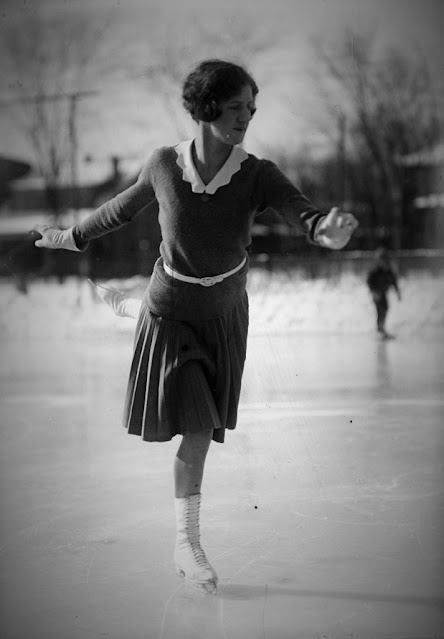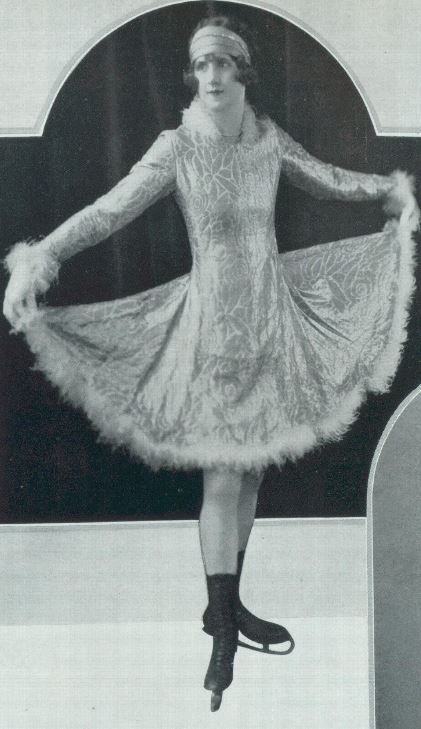Photo courtesy City Of Toronto Archives
"Swanlike in thy realms of pearl,
Tossed by silver clouds of snow;
Like some dainty elfin girl
Dancing in Auroral-glow!
Sway and leap in utmost bliss,
Till thy brittle senses swoon,
And the sun-god's ardent kiss
Ends thy happy, fragile bloom."
- "Ice Flower", poem composed in honour of Constance Wilson after the 1928 World Championships in London, England
On January 8, 1908 in a Toronto hospital, vinegar manufacturer William DeLeigh Wilson celebrated as his wife Jessie (Cumyn) gave birth to their daughter Constance Montgomery Wilson. Constance - or 'Connie' to friends - grew up in relative affluence at the family's home on Walmer Road with her parents, younger brother Bud (Montgomery), older sisters Edith and Florence and two maids. As a girl, she attended the exclusive Bryn Mawr school.
Florence (Lila), who was fifteen years older was Constance, was a very proficient 'fancy' skater so skating really ran in the Wilson family. Constance and Montgomery both started skating at the Toronto Skating Club when Constance was six. It wasn't long before she was one the young darlings of the city's skating scene, zooming around the Toronto Skating Club's indoor rink on Dupont Street with efficiency and speed and wowing members with her dizzying spins. She was just as appreciated at Bishop Strachan School, where she was named all-around sportswoman for three years in a row. In addition to skating, she excelled at running and tennis.
Photo courtesy City Of Toronto Archives
Five foot five with blonde hair and blue eyes, Constance had quite a presence on the ice. At the age of fifteen in 1923, she finished third in her first trip to the Canadian Championships behind Dorothy Jenkins and Cecil Smith, beginning nearly a nearly decade long rivalry with Smith, whom she trained with at the Toronto Skating Club. Constance and Cecil traded titles like youngsters traded Pogs in the nineties, with Cecil often having the edge in school figures and Constance the advantage in free skating. Cecil, who was coached by Paul Wilson, later recalled how Constance's coach Gustave Lussi would conveniently drop in on her practice sessions and "it wouldn't be long before Constance had put some of the elements into her program." In 1924, Constance won her first Canadian women's title. The following year, she defended it and added a gold in pairs with Errol Morson to her résumé... and she was just getting started!
Constance Wilson and Gustave Lussi. Photo courtesy City Of Toronto Archives.
After winning her pair of gold medals at the Canadian Championships in 1926, Gustave Lussi paired Constance with her brother Montgomery. The following year, she claimed medals in both singles and pairs at the North American Championships and reclaimed the Canadian women's title, which she held consecutively until 1935, with the exception of 1928, when she instead entered the British Championships and won that too, bringing the famous Martineau Cup back to her Club that year.
Constance Wilson in London in 1928
Though it wasn't uncommon for members of Commonwealth countries to compete at the British Championships, Constance was the first woman who didn't reside in the British Isles to claim the honour. One spectator claimed that Wilson was like "Pavlova in her prime, but Pavlova with winged feet and light as a fawn." In 1927, she was one of the first four skaters in Canada to pass the First-Class Test.
Photo courtesy City Of Toronto Archives.
Constance finished a disappointing sixth at the 1928 Winter Olympic Games in St. Moritz, Switzerland, where Mr. Lussi claimed the judges "criticized Connie for closing her figures to round them out. Up to that time they left the figures open - you never came back to your start - even in 1947 they were doing this. But in 1928 Connie was marked down for closing her figures." Mr. Lussi also claimed, "Constance Wilson was the first female to perform the first real Axel…but she still turned a three afterwards. And, after teaching it to her awhile, I was called down to the Committee room. They told me that I couldn't teach a jump like that to a lady. It was unladylike, likely to hurt her."
Photo courtesy City Of Toronto Archives
In 1929, Constance won her first of five Canadian pairs titles with Montgomery. Unlike Beatrix Loughran from the United States, who achieved monumental success first as a singles skater and later in pairs during the same era, Constance regularly competed in and won titles in both singles and pairs at the same time. At the 1929, 1931 and 1933 North American Championships, Constance and Montgomery made a clean sweep of the singles and pairs titles. In 1933 in New York City, they finished second in fours as well.
Constance and Montgomery Wilson
Constance and Montgomery almost pulled off a fourth medal sweep in singles and pairs in Montreal at the 1935 North American Championships, but after winning the singles events lost the pairs title to Maribel Vinson and George E.B. Hill. Only three years prior, Constance and Montgomery had appeared alongside the American pair in the first club-sponsored summer figure skating carnival in history.
Top: Constance and Montgomery Wilson. Photo courtesy City Of Toronto Archives. Bottom left: Constance and Montgomery Wilson. Photo courtesy "Skating" magazine. Right: Constance Wilson.
l,
Cecil Smith wasn't the only skater that Constance butted heads with during her time at the top. Joseph Chapman recalled, "In the many times I have acted as 'Ice-contact Man' in carnival performances - and more particularly in the exacting rehearsals preceding these performances, I have come perhaps into closer spiritual touch with our star skating performers than most other people. Long ago I realized that there are many instinctive requirements necessary to a champion, or near-champion, exhibitor or competitor, in order that an inner, personal goal may be closely approached - actually reached. Some while ago I began to suspect that these inner goals might be individual 'subjective idealisms' inherent in each of these skaters. At once I began to take a much more lenient and sympathetic view of certain manifestations that have come within my ken. Thus I could evaluate the urge which drove fascinating Vivi-Anne Hultén into absorbing fifty valuable minutes for her rehearsal at Atlantic City... when she was practicing her artistically exacting, interpretive-dance exhibitions. I could even understand the probable annoyance of flashing Connie Wilson, singles champion of North America (to mention only one of her titles) because Vivi was taking so solid an amount of time, when we were so pressed for time and there were so many other champions desirous of rehearsing. It was quite understandable to me that Connie whirled into her practice as soon as possible after Vivi - taking only some two minutes in order to demonstrate, no doubt, that there were other high-magnitude stars who could execute brilliant performances without elaborate preparation. This may have been merely another demonstration of a personal 'subjective idealism.'"
Constance Wilson and Louise Bertram selling Sergeant Ken Gibb tags for the blind. Photo courtesy City Of Toronto Archives.
Though her successes at the Canadian and North American Championships were unprecedented, Constance consistently seemed to be plagued by bad luck at the most inopportune moments. At the 1932 Winter Olympic Games in Lake Placid, she faltered on one jump in her free skating performance, marring a performance described by Associated Press writers as otherwise "highly impressive". That one mistake narrowly cost her the bronze medal in the women's event. The positive takeaway from the Olympics for Constance was the fact that she and Mary Littlejohn both got to represent Canada. They were next-door neighbours growing up on Walmer Road.
At the World Championships in Montreal, Constance and Montgomery only managed to place sixth in the pairs event. Though she won the bronze medal in the women's event - becoming only the second Canadian woman in history to medal at the World Championships and the first to do so in her home country - the sting of losing the silver so narrowly to Fritzi Burger was palpable.
Most crushing of all was what happened at the 1936 Winter Olympics in Garmisch-Partenkirchen, Germany. Considered a bona fide medal contender in both singles and pairs after training up a storm with Walter Arian, Constance collapsed during practice while suffering the effects of a bad case of the flu and was forced to withdraw from both events. Aside from a trio of medals in the Waltz and fours events at the Canadian Championships with Montgomery in the late thirties and the Toronto Skating Club's Waltz title in 1941 with Gordon Jeffery, her competitive figure skating career was all but over. After retiring from competition, Constance remained active in the sport as a judge for a time.
Most crushing of all was what happened at the 1936 Winter Olympics in Garmisch-Partenkirchen, Germany. Considered a bona fide medal contender in both singles and pairs after training up a storm with Walter Arian, Constance collapsed during practice while suffering the effects of a bad case of the flu and was forced to withdraw from both events. Aside from a trio of medals in the Waltz and fours events at the Canadian Championships with Montgomery in the late thirties and the Toronto Skating Club's Waltz title in 1941 with Gordon Jeffery, her competitive figure skating career was all but over. After retiring from competition, Constance remained active in the sport as a judge for a time.
Left photo courtesy "Skating" magazine
Late in her competitive career, Constance had married a "tall, dark and handsome" engineer named Norman Mandelshon Samuel. Norman, the son of a Conservative candidate for the British House Of Commons, was the only Jewish person to gain admittance to the Toronto Skating Club at that time. The couple later moved down to the States, had a son named Sigmund (after Norman's father) and later divorced. Ron Vincent recalled the couple making a rare visit back home to Toronto: "On a dance session, Constance, whom I had not until then met, grabbed me for a very vigorous dance. My God, she was strong - and she led the whole way. It was a thrill!"
Photo courtesy City Of Toronto Archives
Constance remarried to another engineer, Alfred Daniel Slatkin of Montreal. When he was offered a position as the President of the Allied Automotive Corporation, they moved to Birmingham, Michigan. Constance became a mother of two more sons during World War II.
Constance's family relocated to Kansas City, Missouri in January of 1952, when her husband took a position as the superintendent of the final assembly at the Ford aircraft plant in Claycomo. She sadly passed away of cancer in Kansas City on February 28, 1953 at the age of forty-five. She was inducted posthumously into the CFSA (Skate Canada) Hall Of Fame in 1990, and to this day still holds the record for the most Canadian titles won by any man or woman in multiple disciplines!
Skate Guard is a blog dedicated to preserving the rich, colourful and fascinating history of figure skating. Over ten years, the blog has featured over a thousand free articles covering all aspects of the sport's history, as well as four compelling in-depth features. To read the latest articles, follow the blog on Facebook, Twitter, Pinterest and YouTube. If you enjoy Skate Guard, please show your support for this archive by ordering a copy of the figure skating reference books "The Almanac of Canadian Figure Skating", "Technical Merit: A History of Figure Skating Jumps" and "A Bibliography of Figure Skating": https://skateguard1.blogspot.com/p/buy-book.html.

















